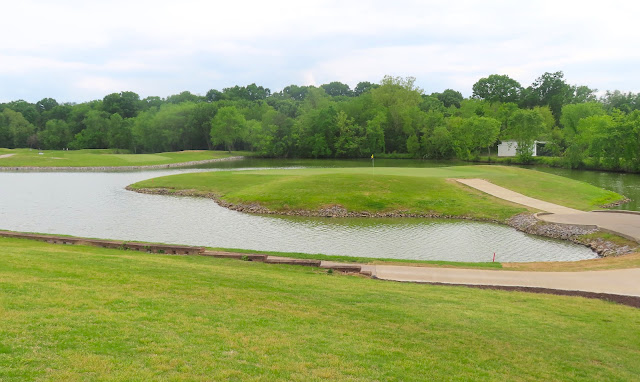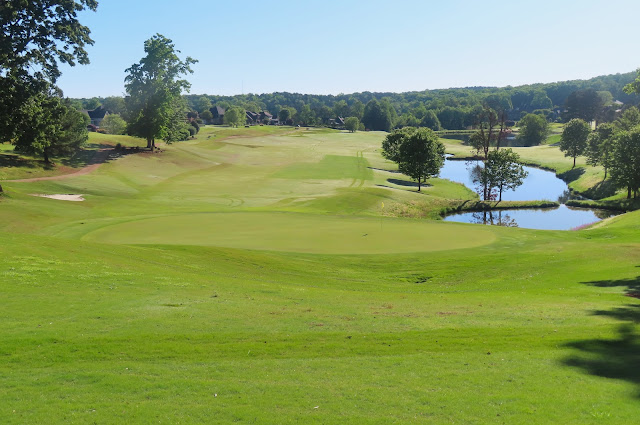I spent a lot of time in Kentucky in the mid 2000's. My aunt lived in Florence, Kentucky, which is just south of Cincinnati. I tried to visit her at least once a year and managed to play quite a few courses over the years. After she passed away in 2017, I focused on other parts of the country. This trip was about playing all the courses I hadn't had a chance to visit yet.
 |
| Louisville Country Club |
Day one of the trip began in Richmond, Kentucky. Home of Eastern Kentucky University, I was there to play Gibson Bay Golf Club. I began right after sunrise on the eighteen hole course designed by Michael Hurdzan. As a designer, Hurzdan typically likes big cloverleaf like bunkers, but that wasn't what I saw at Gibson. The course used the topography more, and relied less on bunkers for its challenge.
 |
| Gibson Bay Golf Club, Par four 10th hole |
I followed up my round on the big course with a trip around the short course at Gibson Bay, also designed by Hurdzan.
 |
| Gibson Bay Par Three Course, 8th hole |
I headed to Lexington for my last round on day one. Griffin Gate Golf Club is owned by Marriott and was originally designed by Rees Jones in 1981. Jones completed a renovation of the course in 2015. The routing felt a little squeezed in on the front, but overall the course was quite fun.
 |
| Griffin Gate Golf Club, Par three 4th hole |
The second day of the trip also took place in the Lexington area. First up was Kearney Hill Golf Links located in the northern part of Lexington. Kearney Hill is a municipal course designed by Pete & P.B. Dye in 1989. The Dyes knew their audience with this course and made it more playable than the average Dye course. The routing is very creative, and I was pleasantly surprised by how much I enjoyed this course.
 |
| Kearney Hills Golf Links, Par three 12th hole |
 |
| Golf Club at Widow's Watch, Par four 18th hole |
The last course I played on day two hosts a PGA Tour event every year. Champion Trace Golf Club typically hosts the tour event opposite the Open Championship, but this year it is opposite the Scottish Open. They keep the rough very long, so accuracy is very important. I thought the course was pretty hard, but of course the tour pros destroy it, with the winning score always being in the 25 under ballpark almost every year.
 |
| Champion Trace Golf Club, Par three 2nd hole |
Unfortunately, the theme of day three was rain. It took place in the Louisville area with off and on rain showers providing a challenge for decent pictures, but it was still a wonderful day of golf with the surprise of the trip coming late in the day. I began the day at the nine hole Crescent Hill Golf Course, which has been around since 1926. The hill part of the name is appropriate as the course is very undulating!
 |
| Crescent Hill Golf Course, Par four 9th hole |
Next up on day three was the city owned Seneca Golf Course. I started with the par three course at Seneca.
 |
| Seneca Par three course, 2nd hole |
I tackled the big course at Seneca next. Wonderful use of the topography made this a delightfully fun experience.
 |
| Seneca Golf Club, Par four 18th hole |
The final course on day three was the biggest surprise of the trip. I knew that Louisville Country Club would be good because it was designed by Walter Travis. Travis is a Golden Age designer who was well known for his eccentric bunkering and bold greens. The course he built at Louisville is full of character, and is placed perfectly on the severely undulating piece of property. Travis handled the transitions with some very bold uphill and downhill holes to absolute perfection. I would love to play there every day.
 |
| Louisville Country Club, Par four 10th hole |
Golf in the Louisville area continued on day four of the trip. Heritage Hill Golf Club is located about 25 miles south of Louisville in Shepherdstown. The course opened in 2007, and was designed by Douglas Beach. The par threes are the real star on this course, as two are of the dramatic drop shot variety.
 |
| Heritage Hill Golf Club, Par three 11th hole |
On the drive back up to Louisville, I decided to check out Penn Run Golf Course. This basic course uses the elevation for its challenge and variety.
 |
| University of Louisville, Par four 18th hole |
Day five of the trip took place in Indiana. First up was Sultans Run Golf Club in Jasper, Indiana. The course was designed by Indiana local Tim Liddy, who built many courses for Pete Dye. You can see the Dye influence in the design. I loved the course, but my one regret was trying to hit driver too much off the tee. Accuracy is very important on this course and I was not disciplined enough to play the smart shot sometimes!
 |
| Covered Bridge Golf Club, Par four 7th in foreground, Par three 8th in background |
I began day six of the trip just north of Lexington at Houston Oaks Golf Club in Paris, Kentucky. A mix up in the tee time resulted in my having to wait almost an hour for somebody to show up. Even though I had booked a 7 am tee time, when the tee time system hit June, the first tee time was changed to 7:45 so my time was moved back. Of course nobody told me this, so I just had to sit there.
 |
| Woodlake Golf Resort, Par five 1st hole |
On the last day of the trip I returned to my home state of South Carolina. I spent some time playing courses in the upstate. I began at Pickens Golf Club which used to have 18 holes but now has nine with the other nine being converted to housing.

















































